1H-NMR spectra in deuterated DMSO of (a) ascorbic acid and (b.deuterated Form
You can identify exchangeable protons in your proton NMR spectrum with a very simple technique called a "D2O shake". For some reason this simple technique, used frequently years ago, seems to be used so much less today. All you do is run a 1H NMR spectrum of your sample then put a single drop of D2O in the tube, shake it, and run another spectrum. The exchangeable protons will exchange with the deuterium in the D2O and disappear from the spectrum. The D2O does not have to be miscible with the solvent.
Below is a partial proton spectrum of menthol in CDCl3. The bottom trace
is the spectrum before the addition of D2O and the top trace after 1
drop of D2O was shaken with the sample. The -OH peak has clearly
disappeared.

Deuterated chloroform is a very inexpensive solvent suitable for many organic compounds, however, the proton spectra of compounds dissolved in CDCl3 often have overlapping peaks complicating the interpretation of the data. One solution is to use a higher magnetic field strength but, what if you are already using the highest available field? One method used a great deal in the past seems to have been forgotten - the use of an aromatic solvent like benzene or pyridine. These solvents induce shifts in the resonances of the solutes often providing dramatically better resolution. Below is an example of the 500 MHz spectrum of tropolone. This compound undergoes fast exchange between the two tautomers indicated in the figure. The bottom trace is the spectrum in chloroform-d and the top trace is spectrum of the same sample in benzene-d6. The exchangable proton is broad and not shown in the figure. The improvement in resolution in the top trace compared to the bottom trace is remarkable.
 The next time you are fighting a resolution problem, try using benzene-d6 as your solvent!
The next time you are fighting a resolution problem, try using benzene-d6 as your solvent!
Several times a year I will get a question like, "I just deuterated my compound and now I can't see the 13C NMR signals for the deuterated carbons - why not?" There are at least three reasons why seeing these signals may be difficult. First of all, the principal relaxation mechanism for protonated carbons is the dipolar interaction between the 13C and the attached protons. When the protons are replaced by deuterium the dipolar mechanism for relaxation is much less efficient and the T1 for the deuterated carbon may be more than an order of magnitude greater than that of the comparable protonated carbon. The long T1 for the deuterated carbon may mean that it will be saturated when using the "standard parameters" and either not show up or be of much reduced intensity. Secondly, the intensity of the carbon signal will be split into a multiplet due to 13C - 2H J coupling depending on how many deuterons are attached to the carbon (1:1:1 triplet for CD, 1:2:3:2:1 pentet for CD2 and 1:3:6:7:6:3:1 septet for CD3). This means that the intensity of the proton decoupled CHn singlet will be spread over all of the lines of the 13C - 2H J multiplet with a corresponding large decrease in signal-to-noise ratio for any one of the lines of the multiplet compared to the proton decoupled singlet for the CHn carbon. Thirdly, there is almost no nuclear Overhauser enhacement for deuterated carbons as there are no directly bound protons. This means that if proton decoupling is applied both during the acquisition and the recycle delay, the protonated carbon signals will grow at a much faster rate than the deuterated carbon signals as the number of scans is increased. In the figure below is an example. The lower panel shows the partial spectrum of a protonated organic molecule using proton decoupling during both the acquisition time and the 2 second recycle delay. The middle panel shows the similar spectrum of a partially deuterated molecule. Note that the deuterated carbon signals are "lost". The top panel shows a spectrum acquired with the same number of scans as that in the middle panel but with a 60 second recycle delay and decoupling only during the acquisition time (i.e. not during the recycle delay). Acquirng the data in this way eliminates the problems of long relaxation times and differential nOe's. In this spectrum one can see the deuterated carbon signals however the signal-to-noise ratio is lower than those for the protonated carbons due to the splitting from 13C - 2H J coupling. In this particular case also, a further loss in signal-to-noise ratio results because the nitrogen bearing carbon is also broadened due to partial self decoupling of the 14N from the 13C.
Bottom line - collect your data over a long period of time with a long recycle delay and inverse gated proton decoupling.
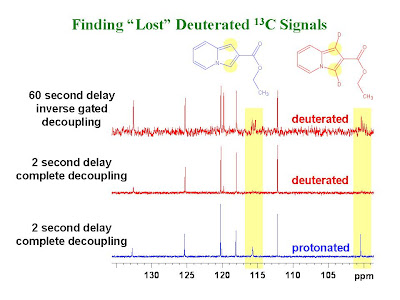
One can simplify 1H NMR spectra by eliminating exchangeable proton signals. This is most commonly done by adding a drop or two of D2O to the NMR sample. The deuterium from the D2O replaces the exchangeable protons (-OH, -NH, -NH2, -COOH) of the sample and their 1H signals disappear. The disadvantage of this technique is the introduction of a strong HDO signal which may overlap with other signals in the spectrum and thereby hinder the interpretation.
An alternative of the "D2O shake" is to add a drop or two of concentrated trifluoroacetic acid (TFA) to the sample. TFA has a single exchangeable proton at ~ 14 - 16 ppm. The -COOH proton of the TFA exchanges with the exchangeable protons in the sample. The exchange rate is usually fast enough on the NMR time scale such that the resultant spectrum has a single broad resonance representing all of the exchangeable protons at a chemical shift between the chemical shift of the pure TFA and that of the exchangeable protons in the sample (usually >10 ppm depending on the sample and the amount of TFA added). The broad peak at a shift > 10 ppm is not likely to overlap with other resonances in the spectrum and therefore will not hinder the interpretation of the data. An example of the use of TFA is shown in the figure below.
The bottom spectrum is that of sucrose dissolved in DMSO-d6. One can observe all of the -OH protons in addition to all of the other sugar protons. The middle spectrum is that of pure TFA in DMSO-d6. The -COOH resonance appears at ~ 15.6 ppm. The top spectrum is that of sucrose in DMSO-d6 with a drop of TFA added. One can see that all of the -OH protons of the sugar (highlighted in yellow) have combined with the -COOH resonance of the TFA yielding a single broad resonance at ~ 13 ppm as a result of the exchange. In addition to moving the -OH resonances out of the way, one can see simplifications to the other sugar protons as the result of loosing the J coupling between the -OH protons and the remaining sugar protons.
A comparison of the use of TFA compared to D2O as an exchange agent is shown in the figure below.
Both methods produce similar results except that the spectrum with added D2O has a large HDO peak (off-scale in the figure) which overlaps with other signals.
When one acquires a 13C NMR spectrum of a sample, the deuterated solvent is observed with resonances characterized by the J coupling pattern of the deuterons attached to the carbon atoms. (CD = 1:1:1 triplet, CD2 = 1:2:3:2:1 quintet, CD3 = 1:3:6:7:6:3:1 septet). Often, however; small peaks are observed near the main solvent resonances. These are due to other isotopomers of the solvent. An example of this is shown in the bottom spectrum of the figure below for the high frequency resonance of "THF-d8". The spectrum consists mainly of the expected 1:2:3:2:1 quintet however, there is a small peak present on the high frequency side of the quintet marked by the arrow. It is due to one of the components of the C1 resonance from THF-1,2,2,3,3,4,4-d7. The supplier of the solvent claims that the isotopic purity is 99.5 atom % D. If the deuteration is uniform, approximately 0.5 % of the molecules will contain a single proton. Half of these molecules will be mono-protonated on the high frequency carbons. If a DEPT spectrum is acquired on the same sample, the non-protonated carbons are suppressed leaving only the mono-protonated carbons. This is shown in the top spectrum of the figure, which shows a 1:1:1 triplet from CHD. The isotope shift between CHD and CD2 is 0.354 ppm.

Erotic temples of india
Although figurines in ancient Indian temples often
depict cultural and religious life, curiosity piques at the exquisite
sculptures of amorous couples in hedonistic love lock says Piya Bose
Khajuraho, Madhya Pradesh
Built by the Chandela Kings who were greatly influenced by Tantric traditions, this temple is said to represent the ultimate seductress.
While the fine sandstone statues built earlier have a well rounded finish, the ones made later are more angular. In his history of the Kamasutra, Mc Connachie describes the amorous sculptures as "the apogee of erotic art", where the twisting, broad hipped and high breasted nymphs, fleshy apsaras and extravagantly interlocked maithunas run riot along the surface of stone.
The various scenes of passionate love making, in acrobatic postures that sometimes border on the physically impossible, strike viewers. Look out for the bold panels of multiple partners engaged with each other. For an interesting perspective on Khajuraho, watch the Sound and Light show. The best time to visit is during the Khajuraho Dance Festival in the first week of February.
Markandeshwar Temple, Maharashtra
Near the naxal district of Gadchiroli, the Markandeshwar temple complex, by the River Wainganga, showcases a sprinkling of erotic art. A couple performing ‘fellacio’ will raise eyebrows. Know to be built by danavas (evil forces) in one night, the temple is made from stone, and follows Hemadpanth architecture. The annual fair during Mahashivratri attracts devotees from far and wide every year. Hiring a car from Nagpur is recommended, unless you fancy hitch-hiking with villagers past moonlit fields or changing several buses and autos. If you're stranded, look for the dharamshala near the temple.
Padawali Temple, Madhya Pradesh
In Morena district near the Chambal Valley, once notorious for dacoits, lies the fortress of Padawali. Two stalwart lion statues greet you at its entrance. The temple inside has earned the reputation being a 'Mini Khajuraho' due to the prevalence of erotic art. The difference between big brother Khajuraho and Padawali Temple, is that the erotic art here seems less acrobatic and more ‘real life' and 'doable’. The carvings of maithunas in various positions, ranging from simple to difficult almost brings the Kamasutra to life.
Ranakpur Jain Temples, Rajasthan
This marble temple of superlative beauty is a ‘vision in white’ with its domes, shikharas and turrets. Over 1,444 intricately carved marble pillars hold up the temple and a monolithic marble rock depicting over 100 snakes catches the eye. Look out for a panel depicting several experimental love making scenes, in a line with a central queen-like figure seated on a throne, with an amorous midget on her lap. It's interesting to note that not only Hindus, but even Jains decorated temples with erotic art. It hints at how nudity had a religious connect due to the 'Digambara’ ideology or the Tantric cult.
Sun Temple, Orissa
When I first visited the Sun Temple at Konarak in Orissa, as a giggly 16-year-old , I was taken aback by how the panels revealed way more about the ‘birds and bees’ than our biology classes had taught us. My second visit recently, helped me appreciate the beautiful erotic art better. The brazenness of the sculptures here gives Khajuraho stiff competition; one of the most scandalous panels is of a dog licking a woman’s genital area. I overheard a guide say, "this was considered a cure for sex related infections, as the dog’s saliva has antibiotic properties." Scenes of polygamy, polyandry and lesbian love are blissfully abundant.
An architectural genius, this temple shows the Sun God on a colossal chariot drawn by seven horses. The word Konarak is a combination of Kona (corner) and Arka (Sun). The temple was previously located closer to the sea, but the magnetic properties of its stone caused shipwrecks. This, along with the dark colour of its stones, earned it the tile of 'The Black Pagoda'. An interesting study in contrast is the famous Jagannath Temple at Puri, also referred to as ‘The White Pagoda' due to its whitewashed walls. If you are an art enthusiast you must visit the Konarak Archaeological Museum nearby that contains fallen sculptures from the temple.
Sun Temple, Gujarat
It is believed to be the place where Lord Rama conducted a yagna here to purify himself of the sin of killing a Brahmana-Ravana. Like Konarak, its architecture is such that the temple catches the first rays of the rising sun. The most striking feature of the temple is a perfectly designed Kama Kunda (water tank) meant for ablutions and for a reflection of the temple in the water. It has lateral stone steps leading down to the tank, allowing both direct and diagonal descent from all sides. Carvings of men and women in various acts of sex with small midget like creatures are prominent. However, due to erosion the detailing of the stone carvings is blurred in places.
Osian, Rajasthan
Amidst the sand dunes of Thar, Osian has a cluster of Hindu and Jain temples dating back to the 11 century AD. The Sachiya Mata temple dedicated to the resident Goddess has a gorgeous carved archway leading up to the shrine and has some beautiful depiction of erotic love locked couples, complete with details like the bed on which the couples lie.
Virupaksha Temple, Karnataka
On the banks of the Tungabhadra River, this temple with beautiful pillars and towered gateways dedicated to Lord Shiva in his avatar as Virupaksha. It is one of the oldest functioning temples since the 7th century AD. A panel that catches the eyes depicts a nude woman being 'admired' by men and women around her. It is best to visit the temple, during the Hampi festival in November. While in the area, also check out the erotic art on the pillars of the Achyutaraya temple.
Several other temples in South India like Belur, Halebidu, Somanathapura and Nugguhalli, the Badami and Banashankari temples of the Chalukya times and the Vijayanagar temples of Bhatkal and Lepakshi also have a profusion of erotic art. The Meenakshi temple of Madurai and Veeraranarayan temple of Gadag have erotic sculptures on their Gopuram. (Information about other temples with erotic art in South India taken from www.kamat.com)
No one has summed up the beauty of erotica on temple walls better than Tagore while he was referring to Konarak, 'The language of man here is defeated by the language of stone.’
MORE
14 Temples In India Where You Get A Lot More Than Just The Traditional Prasad
We Indians even have a god for sex - Kama. So it is only natural that we have erotic sculptures on our temples. There have been many questions raised on the reason behind having erotic sculptures and sexual imagery in a place otherwise considered so 'holy' and 'pure'. There are a few theories floating about but the most popular one seems to be that in order to enter a place so pure, you need to relieve yourself of all your desires and lust. It is by acceptance of lust and desire in you that you can learn to control it. Furthermore, these sculptures are always on the outer walls of temples meaning that the humans need to leave their desires outside before stepping in. In many Indian manuscripts, sex was considered to be spiritual and not hedonistic. There are many such theories but the fact remains that these temples are known more for their erotic sculptures than the deities residing inside.
1. Khajuraho, Madhya Pradesh
The most famous of the lot, Khajuraho temples are located in Madhya Pradesh in the small town of Khajuraho which they are named after. It is not just one temple but a group of temples. It is rumoured that Shiva and other deities visited the region during ancient times to play and hence, the temples were created in their honour. All Khajuraho temples, except one, face the east and the architecture of the temples is designed in a way that is a perfect integration of male and female deities and symbols. The artwork outside the temple, that is found to be the most interesting by tourists, is a depiction of the four goals of Hinduism - Dharma, Artha, Kama and Moksha. Hence, all the erotic imagery that has so enthralled tourists.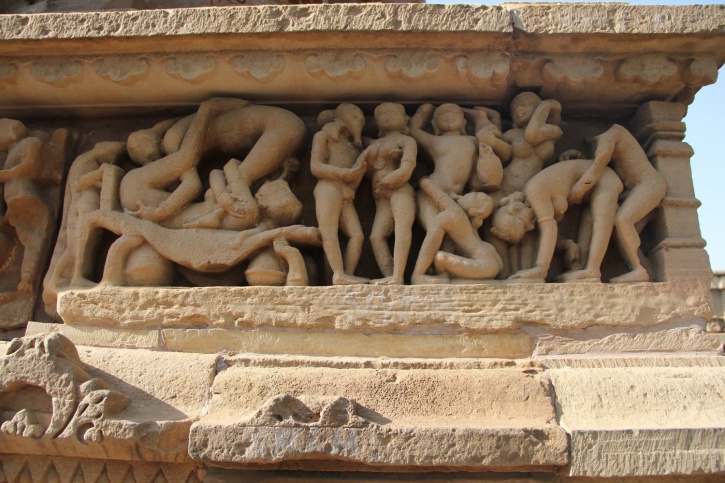
From Tigers to Tombs Wordpress Blog
2. Sun Temple, Konark
The Sun Temples of Konark are one of the most famous Sun Temples of India. Dedicated to the Sun God, the temple was created in the early 13th century and is also called by the name 'Black Pagoda'. Konark Sun Temple is in the form of a giant chariot and the stone wheels, pillars, walls are all exquisitely and intricately carved. Unfortunately, most of the carvings are now in ruins due to natural calamities and foreign invasions. The temple is known for 'Maithunas' which are the erotic sculptures on the temple walls. Britishers have called the Konark Temple 'most beautiful and yet the most obscene'. However, the erotic sculptures on the Sun Temple are explained by archaeologists, especially by A.K. Coomaraswamy, stating that the sculptures are a depiction of Indian sex-symbolism which is ‘sacramental’ in its likeness to the union of the individual soul with the universal spirit. The sculptures are a part of Samsara which the human must ultimately give up to reach within, on the path of Moksha.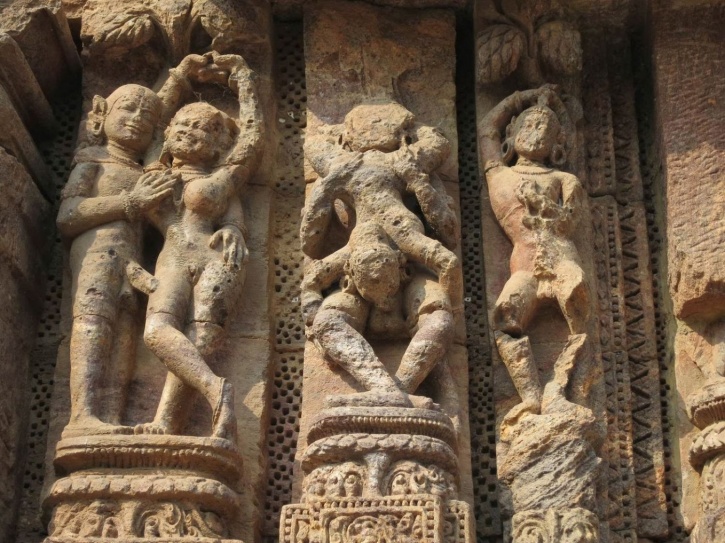
Insights India Blogspot
3. Jagdish Mandir, Udaipur
Originally known as the Jagannath Rai temple, Jagdish Mandir is a famous temple in Udaipur. The temple is dedicated to Lord Vishnu and is a 3-storeyed temple elaborately carved. While the main structure inside the temple is of black stone, other structures are made of metals like brass. The temple walls even have inscriptions belonging to the time of Maharana Jagat Singh under whose reign the temple was constructed. The Jagdish Mandir temple also has some erotic imagery and the explanation for the same is in keeping with the others - that the outer walls of the temple symbolise the worldly pleasures that humans need to give up to reach the inner sanctum or God.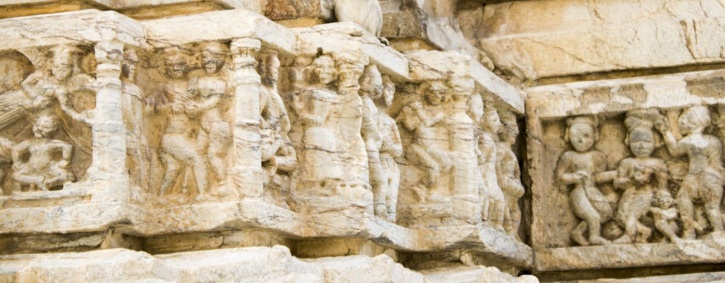
Sonya and Travis
4. Markandeshwar, Maharashtra
Located in a small district in Maharashtra is the Markandeshwar Shiv temple. Located on the banks of the river, the temple is believed to be extremely holy and though not a well known sight, flocked to by locals and tourists from within the state who believe in the power of the deity residing in the temple. The outside of the temple is architecturally different from the other temples as it belongs to a different ear. But the intricate carvings have been preserved to day. Some of the carvings include sexual imagery which some say is the work of demons as the temple is said to have been mysteriously constructed within one night.
Blogspot
5. Padawali, Madhya Pradesh
Lost in the greenery near Chambal river, the Padawali ruins still stand tall and beautiful, ensnaring tourists who visit the tiny village. The temples are Shiv and Vishnu temples which have faced a lot of weathering through the ages. Though most of the temples are now in ruins, the statues and carving on the walls, tops and the stairs are still intact, giving people a fair idea of the stories they held. Among the various sculptures, there are also some erotic sculptures on the outer temple walls in various positions.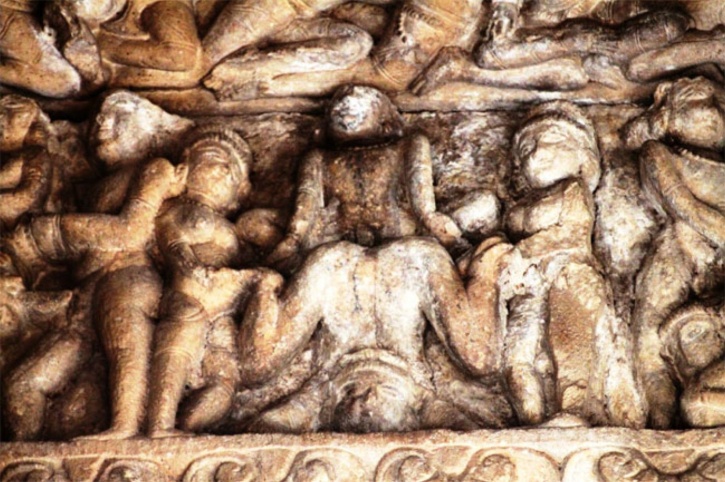
6. Sun Temple, Gujarat
The Sun Temple at Modhera in Gujarat was constructed in the 11th century and lies on the banks of a river. Though the temple is no longer functional as a temple as no prayers or rituals are conducted here, it is still an important tourist place and under the Archaeological Survey of India. The temple has detailed architecture in the form of sculptures representing the different Hindu Gods and the Samudramanthan where the Hindu Gods battled over the elixir of life with the demons. The temple also has erotic sculptures and the reason cited for these sculptures is that in the olden era, sex was neither considered impure nor moralised, as it is today. It was seen as a pure act that brought fertility in the world and helped give birth.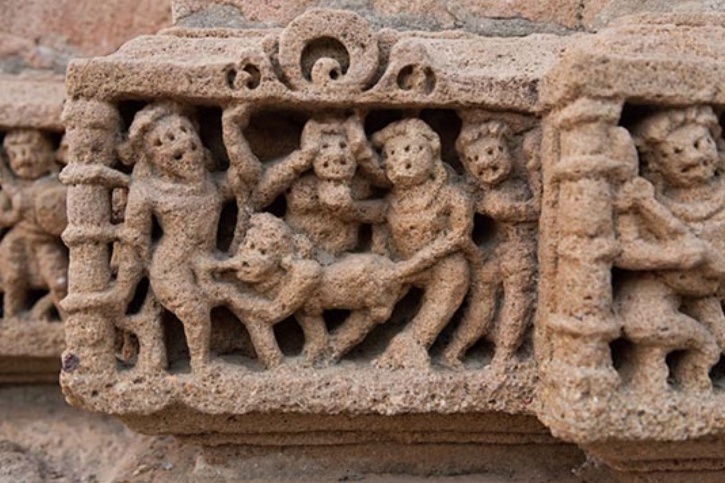
Yogoyo
7. Osian, Rajasthan
The inclusion of erotic and sexual imagery on temple walls is not limited only to the Hindu religion. Even Jain temples have such imagery and sculptures carved on the outer walls of their 'derasars'. Osian is an ancient town located on the outskirts of Jodhpur that was once a bustling trade center but is today a part of the Thar dessert. It boasts of many religious monuments, Osian Jain Temple being one among them. The town, in olden days, saw a mixed Hindu and Jain population with harmony among them and the town was a major center for Jain pilgrims. The Jain temples had tales of Jain priests and Lord Mahavira (the youngest and last Tirthankar) carved on the walls. Along with these sculptures, there were also sculptures of Nagas (entwined snakes) and erotic imagery, giving the people an idea that sex was treated as one of the worldly pleasures, equal to other pleasures, and not looked down upon.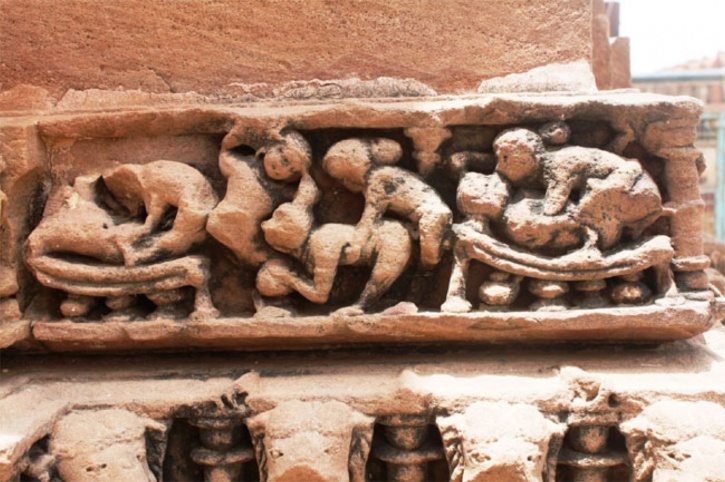
8. Virupaksha, Hampi
Situated in Hampi, Karnataka, Virupaksha temple is a UNESCO World Heritage site and a part of a group of monuments. The Shiva temple boasts of a huge, elaborate structure and is situated on the banks of Tungabhadra river. A tributary of the river also flows through the temple kitchen and terrace. The temple is beautifully structured and has many parts like the sanctum, three ante chambers, a pillared hall and an open pillared hall. The courtyards, steps and smaller shrines lining the temples are also beautifully carved. The temple boasts of some erotic imagery on the outer walls.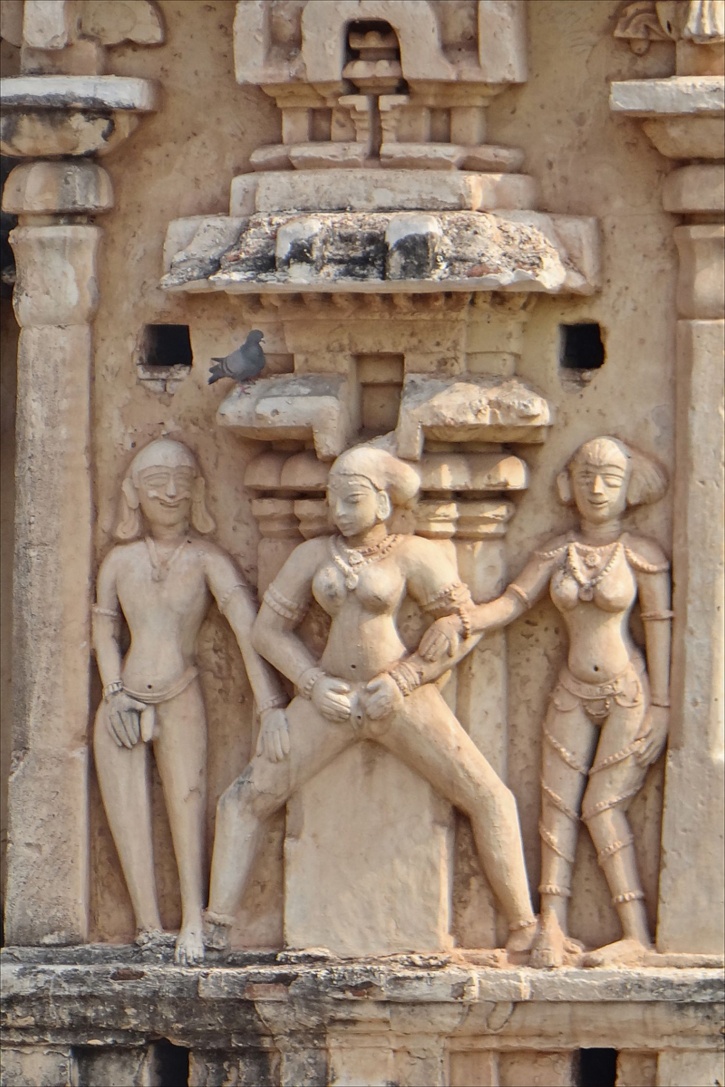
Wikimedia
9. Tripurantaka Temple, Karnataka
Another temple in Karnataka, Tripurantaka temple is a temple constructed in 1070 CE in today what is known as Shivamogga. The temple is mainly famous for the intricate stone carvings that adorn the sides and edges of windows and screens. Also carved on ceilings and walls are multiple mythical animals and tales from Indian epics. The temple has a lot of sculptures from the Kamasutra carved on the outer walls along with a huge mythical 2-faced bird believed to have been carved to scare away elephants from entering the premises.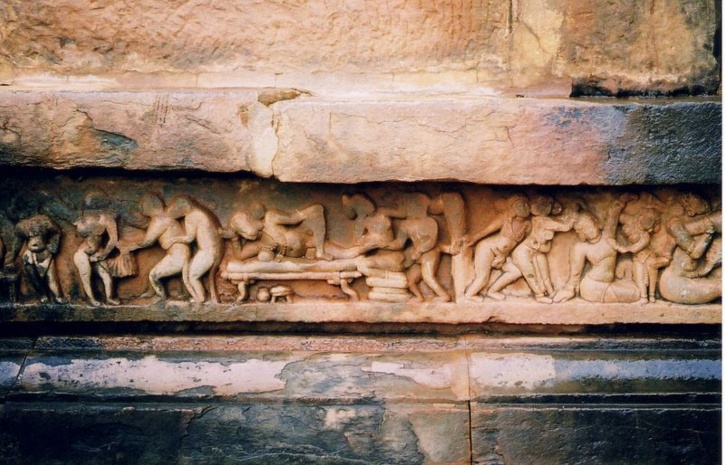
Wikimedia
10. Kailasa, Ellora
Situated in a small part of the Ellora Caves, the Kailasa Temple is dedicated to Lord Shiva. The monolithic structure is designed to resemble Mount Kailasa, the home of Hindu God Shiva. The temple is believed to have been constructed between 757-783 CE by the ruler Krishna and is famous for its vertical creation. In fact, workers started at the top of the rock and continued downwards. The temple has a depiction of Ravana trying to lift Mount Kailasa as a sculpture. The other sculptures carved are done in a way that on the left side, there are sculptures for the followers of Lord Shiva and on the right, for the followers of Lord Vishnu.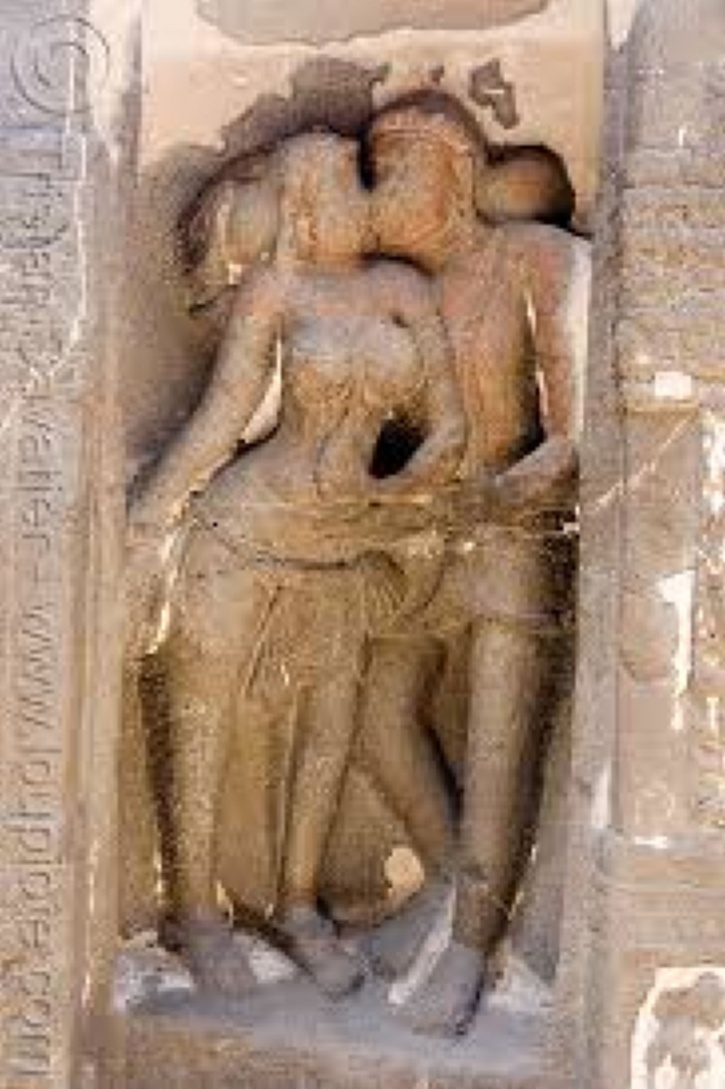
Loupiote
11. Ranakpur, Rajasthan
A temple dedicated to Adinath (also known as Rishabha) the first Jain Tirthankar, Ranakpur Temple is situated close to Udaipur. Though not as popular as Dilwara, many tourists prefer this temple to the Mount Abu one as it is more elaborate and serene. The temple is constructed entirely out of white marble and took 65 years to complete. It has 27 halls that are supported by 1447 pillars and each pillar is intricately carved. The most surprising part about the sculptures is that no two carvings are alike.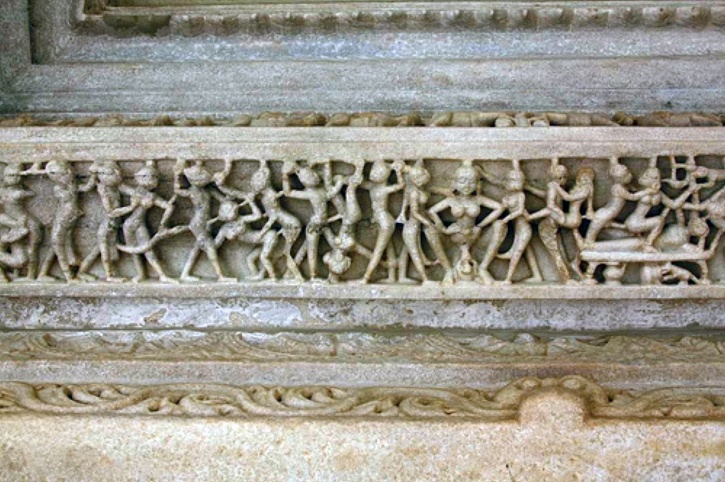
Flickr
12. Bhoramdeo, Chattisgarh
Bhoramdeo temples are located at Chattisgarh and are a group of 4 temples, the earliest of which was built in bricks and the rest in stone. The temple has been described as "scintillating poetry in stone" and the temples are also called the Khajuraho of Chattisgarh, given the number of erotic architecture on the temples. The temple was built under the reign of kings who are believed to have practised Tantrism and Occult and hence, many of the sculptures on the walls are related to occult sciences.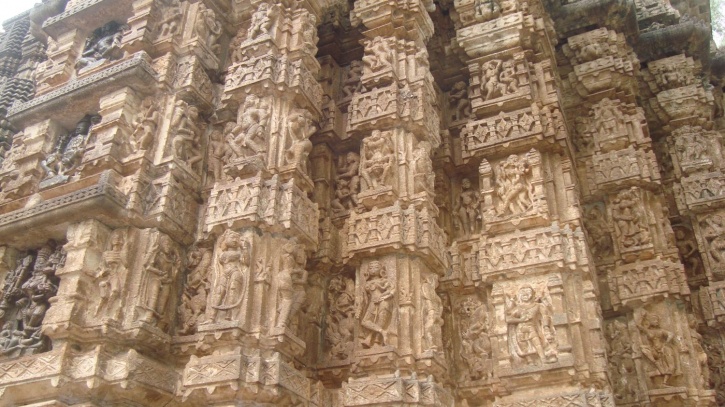
Wikimedia
13. Nanda Devi Temple, Almora
Located in idyllic Uttarakhand, the Valley of Flowers, Nanda Devi temple Uttarakhand is a temple dedicated to Nanda Devi, the consort of Lord Shiva. Legend has it that Nanda Devi left her village and went to the Nanda Devi parbat (mountain). The Nanda Devi fair is held every year around the temple in honour of the Goddess and her sister. The temple is a simple temple but has some erotic carvings on the walls. The symbol of these elements on the temple is urging the people to give up their pleasures to enjoy the afterlife.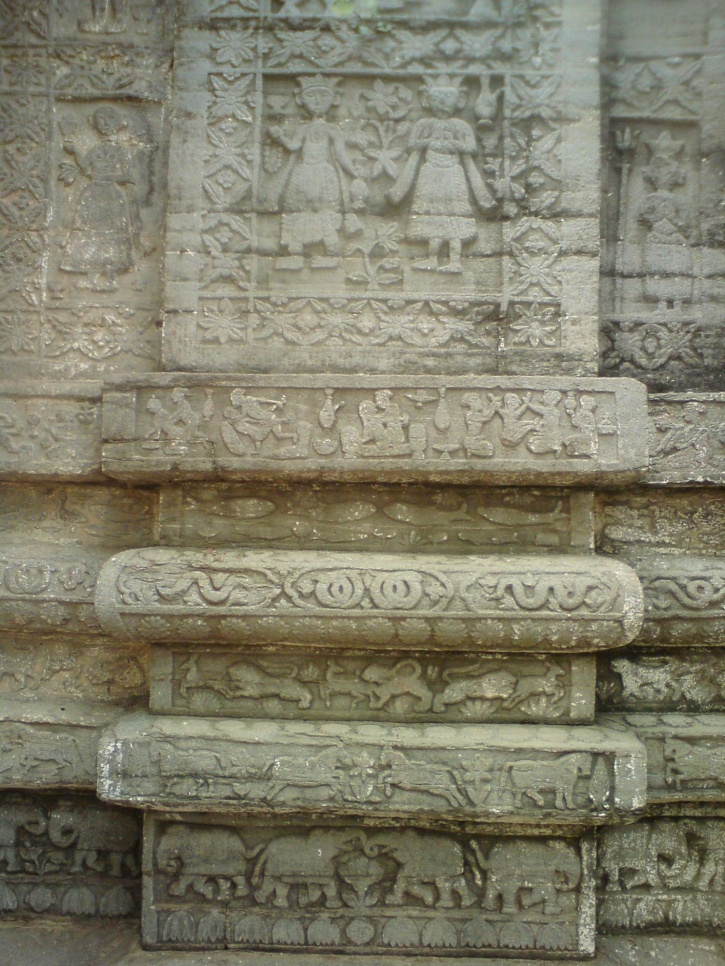
Go Places
14. Lingaraja Temple, Bhubaneshwar
Lingaraja Temple in Bhubaneshwar is a temple dedicated to Lord Shiva and there is also the Harihara form which is the combined form of Lord Vishnu and Shiva. The temple is widely popular with locals and tourists and sees as many as 6000 tourists per day. The temple has animal and mythological graffiti as well as sculptures. The temple also has a lot of erotic art and images from the Kamasutra, the sacred Hindu text on sex.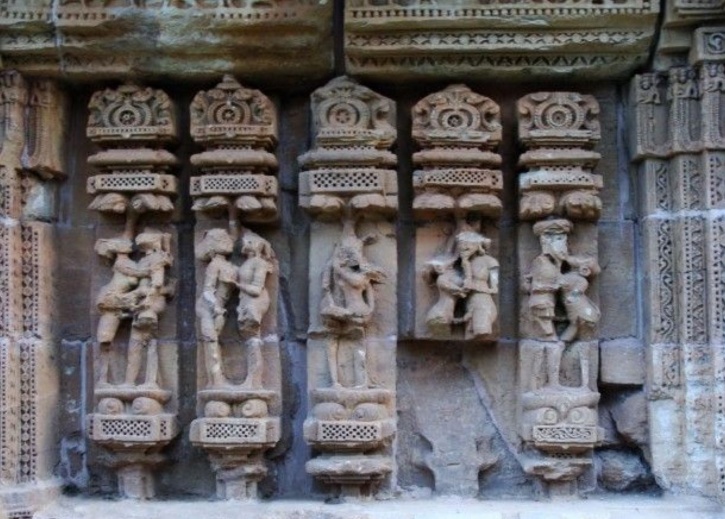
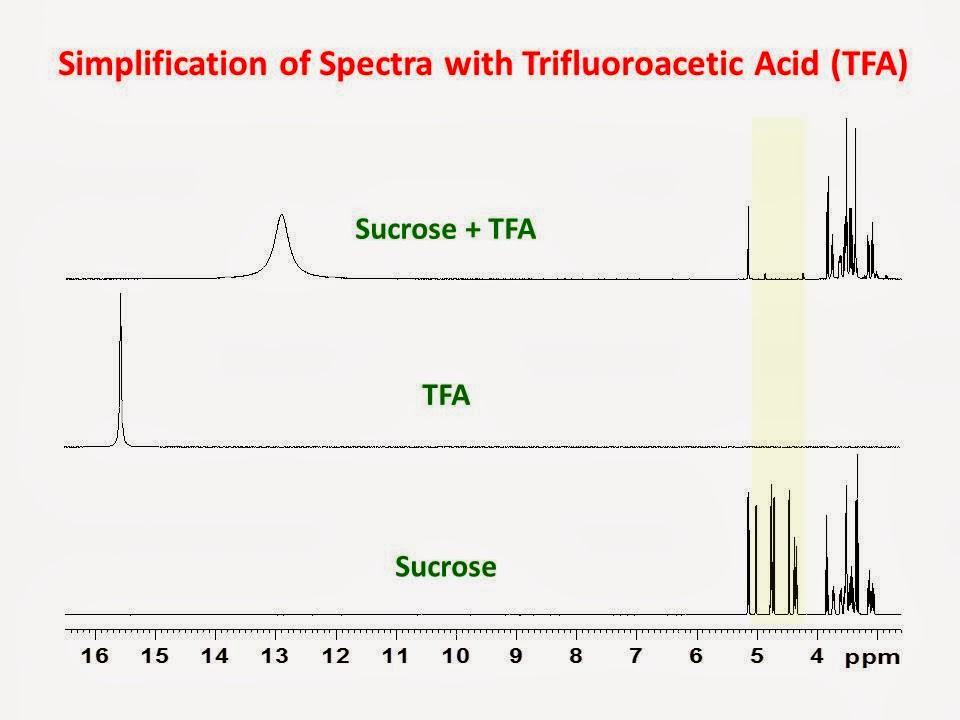

No comments:
Post a Comment